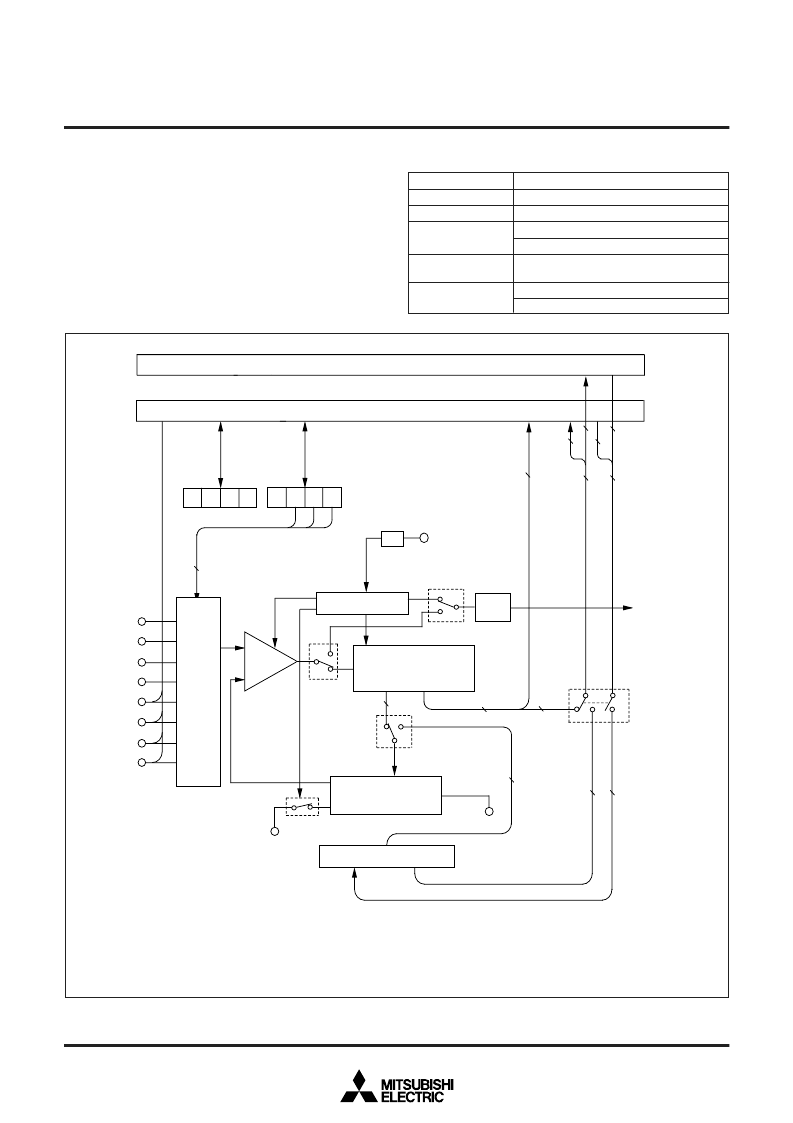- 您現在的位置:買賣IC網 > PDF目錄370838 > M34513E4 (Mitsubishi Electric Corporation) SINGLE-CHIP 4-BIT CMOS MICROCOMPUTER PDF資料下載
參數資料
| 型號: | M34513E4 |
| 廠商: | Mitsubishi Electric Corporation |
| 英文描述: | SINGLE-CHIP 4-BIT CMOS MICROCOMPUTER |
| 中文描述: | 單芯片4位微機的CMOS |
| 文件頁數: | 39/106頁 |
| 文件大?。?/td> | 1304K |
| 代理商: | M34513E4 |
第1頁第2頁第3頁第4頁第5頁第6頁第7頁第8頁第9頁第10頁第11頁第12頁第13頁第14頁第15頁第16頁第17頁第18頁第19頁第20頁第21頁第22頁第23頁第24頁第25頁第26頁第27頁第28頁第29頁第30頁第31頁第32頁第33頁第34頁第35頁第36頁第37頁第38頁當前第39頁第40頁第41頁第42頁第43頁第44頁第45頁第46頁第47頁第48頁第49頁第50頁第51頁第52頁第53頁第54頁第55頁第56頁第57頁第58頁第59頁第60頁第61頁第62頁第63頁第64頁第65頁第66頁第67頁第68頁第69頁第70頁第71頁第72頁第73頁第74頁第75頁第76頁第77頁第78頁第79頁第80頁第81頁第82頁第83頁第84頁第85頁第86頁第87頁第88頁第89頁第90頁第91頁第92頁第93頁第94頁第95頁第96頁第97頁第98頁第99頁第100頁第101頁第102頁第103頁第104頁第105頁第106頁

39
4513/4514 Group
SINGLE-CHIP 4-BIT CMOS MICROCOMPUTER
MITSUBISHI MICROCOMPUTERS
PRELIMINARY
Notice: This is not a final specification.
change.
Some parametric limits are subject to
A-D CONVERTER
The 4513/4514 Group has a built-in A-D conversion circuit that
performs conversion by 10-bit successive comparison method.
Table 14 shows the characteristics of this A-D converter. This A-
D converter can also be used as an 8-bit comparator to compare
analog voltages input from the analog input pin with preset val-
ues.
Table 14 A-D converter characteristics
Parameter
Conversion format
Resolution
Absolute accuracy
Characteristics
Successive comparison method
10 bits
Linearity error:
±
2LSB
Non-linearity error:
±
0.9LSB
46.5
μ
s (High-speed mode at 4.0 MHz
oscillation frequency)
4 for 4513 Group
8 for 4514 Group
Conversion speed
Analog input pin
Fig. 26 A-D conversion circuit structure
Register A (4)
V
SS
V
DD
IAP4
(P4
0
—
P4
3
)
TABAD
1/6
Q2
3
Register B (4)
Q1
1
Q1
0
Q1
2
TADAB
Q2
2
Q2
1
Q2
0
0
1
4
4
4
4
8
8
8
0
1
1
8
10
Q2
3
Q2
3
DAC
operation
signal
0
1
Q2
3
8
8
2
TALA
Q2
3
Q1
3
TAQ1
TQ1A
TAQ2
TQ2A
ADF
(1)
A
IN0
/CMP0-
A
IN1
/CMP0+
A
IN2
/CMP1-
A
IN3
/CMP1+
P4
0
/A
IN8
P4
1
/A
IN9
P4
2
/A
IN10
P4
3
/A
IN11
3
1
0
10
Comparator
8
Instruction clock
A-D control circuit
Successive comparison
register (AD) (10)
A-D interrupt
DA converter
(
Note 1
)
Comparator register (8)
(
Note 2
)
Notes 1:
This switch is turned ON only when A-D converter is operating and generates the comparison voltage.
2:
Writing/reading data to the comparator register is possible only in the comparator mode (Q2
3
=1).
The value of the comparator register is retained even when the mode is switched to the A-D conversion
mode (Q2
3
=0) because it is separated from the successive comparison register (AD). Also, the resolution in
the comparator mode is 8 bits because the comparator register consists of 8 bits.
3:
The 4513 Group does not have ports P4
0
/A
IN4
–P4
3
/A
IN7
and the IAP4 and OP4A instructions.
(
Note 3
)
OP4A
(P4
0
—
P4
3
)
相關PDF資料 |
PDF描述 |
|---|---|
| M34513E8 | SINGLE-CHIP 4-BIT CMOS MICROCOMPUTER |
| M34513M8 | SINGLE-CHIP 4-BIT CMOS MICROCOMPUTER |
| M34514E8 | SINGLE-CHIP 4-BIT CMOS MICROCOMPUTER |
| M34514M6 | CAP 120UF 16V ELECT LXY RAD |
| M34514M8 | SINGLE-CHIP 4-BIT CMOS MICROCOMPUTER |
相關代理商/技術參數 |
參數描述 |
|---|---|
| M34513E4FP | 制造商:MITSUBISHI 制造商全稱:Mitsubishi Electric Semiconductor 功能描述:SINGLE-CHIP 4-BIT CMOS MICROCOMPUTER |
| M34513E4SP | 制造商:RENESAS 制造商全稱:Renesas Technology Corp 功能描述:SINGLE-CHIP 4-BIT CMOS MICROCOMPUTER |
| M34513E8 | 制造商:MITSUBISHI 制造商全稱:Mitsubishi Electric Semiconductor 功能描述:SINGLE-CHIP 4-BIT CMOS MICROCOMPUTER |
| M34513E8FP | 制造商:RENESAS 制造商全稱:Renesas Technology Corp 功能描述:SINGLE-CHIP 4-BIT CMOS MICROCOMPUTER |
| M34513M2 | 制造商:MITSUBISHI 制造商全稱:Mitsubishi Electric Semiconductor 功能描述:SINGLE-CHIP 4-BIT CMOS MICROCOMPUTER |
發(fā)布緊急采購,3分鐘左右您將得到回復。